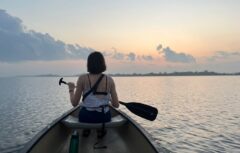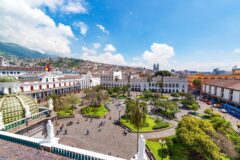Latin America then and now

Sometimes the memory plays tricks, but I have never forgotten Craig, an American traveller who I met in the rat-infested, thief-ridden, grubby, over-flowing toilet absurdly known as the Gran Bolívar Palace Hotel, in the Peruvian city of Cusco.
He had returned from the day trip to Machu Picchu because like all Americans who visited Peru in the 70s he was almost as interested in the culture as the cocaine.
Every night, Cusco’s Plaza des Armas would resound to stoned tourists – high on life and anything else they could find – and for one brief moment he too thought he had achieved nirvana.
“Gee,” he said. “I was sitting in the ruins looking at all the amazing hieroglyphs on the stones. The thought of that ancient civilisation really got to me. Then as the coke wore off I realised they were the numbers put there by archaeologists to show which stone fitted with which.”
From that moment he switched from drugs to rugs and decided to set up a business importing cheap Peruvian goods to his home in Salt Lake City.
It hasn’t been drugs that has muddled my memory of South America thirty odd years later. I remember it as a journey along eucalyptus-filled valleys, dominated by towering mountains, where I marvelled at Incan remains and cathedrals of gilt, haggled in dazzling markets and ate baffling food.
And then I read my diary. It was all of the above but it was also hell. Trains with wooden seats, one so crowded from Cusco to Puno that I spent 14 hours next to a musician, my right buttock snuggled against his French Horn; rides in the backs of trucks fighting for space with sheep and puzzled locals; there were hotels with rats, deadly roads which disappeared in landslides, insurmountable bureaucracy and most of time, altitude sickness which made my head feel it was about to explode.
There were few, if any, tour operators, just trekking companies escorting busloads of miserable students on a trip of a strife time and one guide, The South American Handbook, which took delight in recommending only the dustiest, dirtiest places to stay so I had to make it up as I went along. How to get from Puno to Yunguyo? Stand on this corner and wait for a truck.
Frankly, I had no idea what I was letting myself in for, so when another coke enthusiast called Hays Chumley - you remember a name like that - suggested walking the Inca Trail it was an adventure not be sniffed at.
“It’s got to be done,” he enthused, swigging from a bottle of sweet wine. “All you have to do is walk for four days and you reach Macchu Picchu at dawn. It will be unforgettable.”
It was. A little tourist shop sold maps of the trail hand drawn by Norwegian backpackers which looked straightforward enough - along a valley, over a mountain pass, turn left by a ruin, over another pass and there you are: Machu Picchu.
So I bought a rug from a Cusco market to use as a sleeping bag and off we set. It was a fabulous morning when we got off the train and strolled through the meadows of the Urubamba Valley. Sunny, lots of flowers, friendly locals. We stopped for the night in a village called Wayllabamba, warmed up some soup, played footie with the village lads and slept in the school house.
Nothing prepared us for the climb next day which was a chest-thumping plod to the top of the first pass. Exhausted, freezing, soaked. That was nothing compared to the next day when we turned right at the crucial ruin and almost disappeared forever in a valley of rotting vegetation. One step up, we slipped three back down, clutching on to roots and rotten branches. Did I mention it was raining? I thought I was going to die.
Three days later we were back in Wayllabamba where a farmer gave us a mug of chicory coffee and a tasty helping of guinea pig stew and let us sleep in his shed under a pile of sheepskins. We made it to Machu Picchu like everyone else. By train.
It is all so much easier now thanks to the chap I had arranged to meet in the post restante in La Paz. An old university friend called Chris Parrott – now better known as one of Journey Latin America’s founding directors – who was teaching in Rio de Janeiro at the time. Together we planned to travel across the continent to Rio, starting with the train from La Paz to Cochabamba in the Andean foothills to the east.
The train screeched its way out of the city and clattered through valleys and across the altiplano, sending herds of llamas scattering. Cochabamba here we come.
Except we don’t. First the train backed into a gate at a station and we had to spend an hour or so looking at its mangled remains, then, a few miles later - mud. The line had disappeared under a landslide which stretched for miles. We were going nowhere. We spent the night in a station building while the rain poured steadily, turning the mud into a lake. Bulldozers appeared and pushed aside the mud, the train crept forward, another landslide, more mud, more bulldozing, but 24 hours later we were on our way and rattled off – at last – to Cochabamba.
Thinking back, this could have been the moment that Parrott decided that what Latin America needed was a company to organise the journey.
Now, I am told, the roads from Arequipa to Juliaca and on to Cusco are fully paved. They even have crash barriers. The train from Lima to the mountains has comfy seats, and the hotels are now more likely to come with full board than with rats. The train from Puno to Cusco is run by Orient Express which also provides the service from Cusco to Machu Picchu, complete with plush upholstery, waiter service and vista-dome windows.
Full board? Waiters? I blame Journey Latin America.
Tailor-made holidays
Flexible, custom-made holidays to Latin America created to match your exact requirements: our tailor-made itineraries are as unique as the clients for whom they are designed.
Design my tripPapagaio
Your edit for Latin American inspiration
Our exciting range of articles on Latin America explore everything from iconic destinations and lesser-known cultural gems to delicious traditional recipes. You’ll also find exclusive travel tips, first-hand client reviews and the chance to get your personal questions answered by our travel experts.
View Extraordinary Inspiration






































